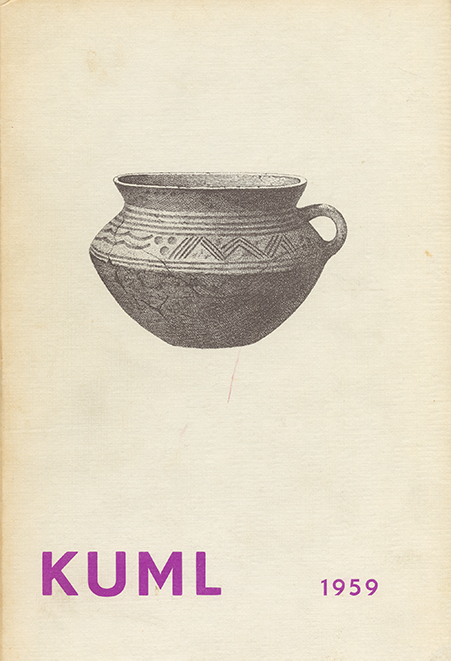Træk af høravlens historie
DOI:
https://doi.org/10.7146/kuml.v9i9.103045Nøgleord:
route of introduction, introduktions rute, Linum, hør, evolution of, historie afResumé
Conclusion.
The two imprints from Arpachiyah and Brak constitute the earliest evidence of the cultivation of Linum. Basing the evaluation of the collected material upon the seed dimensions we may establish two different lines, one pertaining to irrigated land and the other to natural precipitation (Table 8). The maximum seed length for the upland rainwatered areas is 4.03 mm, while for the irrigation areas the maximum lengths show progressive increase, viz., Ur, 4.39, Hama 4.76 and 4.94, Egypt 5.12, and Nimrud 6.20 mm, the last dimension calculated by adding one sixth to the length of the carbonized seeds. The other line proceeded from the foothill country in the East along unknown routes into Central Europe and shows for the first thousand years the following lengths: 3.84 (Switzerland), 3.90 (Italy), 3.84 (Holland), and 4.03 mm (England). In spite of any possible misjudgement by comparison of imprints with actual seeds the difference in length is so small that we must conclude that it is the same species that occurs all the way from Kurdistan to England. The Arpachiyah and Brak are unique not only by being the earliest of all, but also by having been established in the only area here discussed in which a wild species is distributed which stands up to all claims one might make on the progenitor of the cultivated Linum, in respect to general morphology and seed anatomy as well as chromosome number. Thus it seems justified to regard L. bienne as the progenitor of the cultivated L. usitatissimum, whether it is encountered in ancient Egypt or in the Swiss piledwellings. Thus also the Neolithic Swiss Linum may justly bear the specific name usitatissimum. There is, incidentally, no reason to expect that the early Near Eastern imprints will forever remain the earliest evidence; Linum bienne was surely domesticated long before the Halaf culture emerged.
Following the propounded route of introduction of the Danish prehistoric Linum against the current, one arrives at the result that eastern Europe, which today is the centre of the world's flax production, was the direct source of the ancient Danish Linum. lts life form is as yet unknown because no material for study of roots and stems has been discovered in Danish prehistoric deposits. We know that the piledwelling Linum was winter-annual like its Near Eastern progenitor; the western branch of this group was presumably of the same biological type since on its way from Switzerland to England it cannot have passed through areas with a strikingly different climate which could have brought about a change in this respect. Thus we may reckon with all Central-Western European Linum having been winter-annual until otherwise proved, up to the time when the Hallstatt and LaTene influences during the first millennium B. C. broke down the regional barriers of the Bronze Age.
On the Russian steppes, on the other hand, the summer is very hot but not dry enough to bring about premature ripening in Linum. Here the biological change-over may have taken place which caused the plant during a brief vegetation period to develop the simple stem with the long fibres beyond the hot irrigation lands. Consequently, the Danish lron Age Linum may have been summer-annual, but still it is worth considering the possibility that the striking racial difference revealed by the dimensions of the Østerbølle and the Alrum seeds is an indication of both biological types having been grown in Jutland at the same time.
When and how the eastern European Linum reached its outpost cannot be suggested; it is for future research to solve this problem. The mapping out of the necessary route backwards to the south-east can be done only on the basis of new finds in the relevant areas, but even so it is tempting to try to picture the migrations within the obscure triangle Kurdistan-Switzerland-Poland:
Agriculture reached Europe during the fifth millennium B. C., probably by coastal traffic from the eastern Mediterranean to the Aegean region, Greece and western Anatolia. One branch proceeded up along the Danube and to that we presumably owe the Central European Linum. Another may have gone north and skirted the west coast of the Black Sea into Russia, and here Linum found favourable conditions. During the first millennium B. C. the widespread Hallstatt migrations and infiltrations from Central Europe touched the Russian cultural area and among other innovations spread the Linum of the East which was probably summer-annual, to Central and Western Europe and Denmark. Even in our day, Poland, the former "Baltic Countries" and Central Russia constitute the core of the Linum cultivation of this continent and may thus be considered its optimum ecological region under European precipitation conditions.
To paleoethnobotanical research the sporadic occurrence of traces of prehistoric Linum has hitherto presented an unsurmountable difficulty. The figures here compiled, and the constellation of finds seems to me to throw a new light on the dark path of the cultivated Linum, and, although the details of the problem are still unsolved, we have at least some indication of the direction of further endeavours. In collaboration the archaeologist and the botanist may achieve much by following this track, and instead of being a drawback to the understanding of its occurrence, this double-existence of Linum during European prehistory may prove to be a most valuable indicator of man's cultural relations in those far-off days.
Hans Helbaek
Downloads
Publiceret
Citation/Eksport
Nummer
Sektion
Licens
Fra og med årgang 2022 er artikler udgivet i Kuml med en licens fra Creative Commons (CC BY-NC-SA 4.0).
Alle tidligere årgange af tidsskriftet er ikke udgivet med en licens fra Creative Commons.


